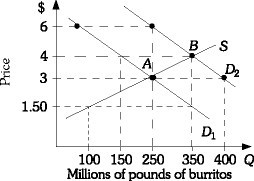If demand is perfectly elastic
A) then a 1% increase in price leads to a fall in quantity of greater than 1%.
B) then a 1% increase in price leads to a fall in quantity of less than 1%.
C) then a 1% increase in price causes quantity demanded to fall to zero.
D) then a 1% increase in price has no effect on quantity demanded.
C
You might also like to view...
In the short-run macro model, an increase in government spending
a. may reduce real GDP b. partially crowds out private investment spending c. usually crowds out exports d. usually crowds out spending on services e. requires an increase in taxes
Government can overcome the free rider problem by collecting taxes and using the funds to provide individuals with nonexcludable public goods that they want to buy but the market cannot provide
Indicate whether the statement is true or false
Marginal cost generally ________ quantity produced.
A. rises with B. determines C. is not related to D. falls with
Refer to the information provided in Figure 3.18 below to answer the question(s) that follow. Figure 3.18Refer to Figure 3.18. The market is initially in equilibrium at Point A. If demand shifts from D1 to D2 and the price of burritos remains constant at $3.00, there will be
Figure 3.18Refer to Figure 3.18. The market is initially in equilibrium at Point A. If demand shifts from D1 to D2 and the price of burritos remains constant at $3.00, there will be
A. an excess supply of 150 million pounds of burritos. B. an excess demand of 100 million pounds of burritos. C. an excess supply of 50 million pounds of burritos. D. an excess demand of 150 million pounds of burritos.